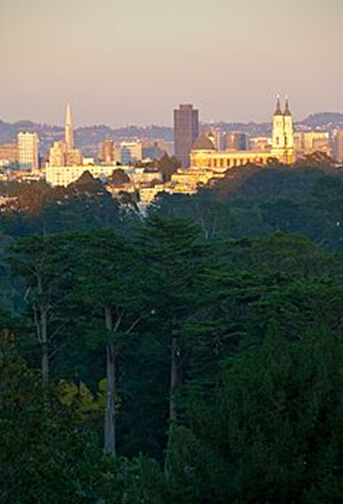Golden Gate Park
usinfo | 2014-06-11 16:19

Golden Gate Park, located in San Francisco, California, United States, is a large urban park consisting of 1,017 acres (412 ha) of public grounds. Configured as a rectangle, it is similar in shape but 20 percent larger than Central Park in New York, to which it is often compared. It is over three miles (4.8 km) long east to west, and about half a mile (0.8 km) north to south.[3] With 13 million visitors annually, Golden Gate is the fifth most-visited city park in the United States after Central Park in New York City, Lincoln Park in Chicago, and Balboa Park and Mission Bay Park in San Diego.
In the 1860s, San Franciscans began to feel the need for a spacious public park similar to Central Park, which was then taking shape in New York City. Golden Gate Park was carved out of unpromising sand and shore dunes that were known as the Outside Lands, in an unincorporated area west of San Francisco’s then-current borders. Conceived ostensibly for recreation, the underlying purpose of the park was housing development and the westward expansion of the city. The tireless field engineer William Hammond Hall prepared a survey and topographic map of the park site in 1870 and became its commissioner in 1871. He was later named California's first state engineer and developed an integrated flood control system for the Sacramento Valley. The park drew its name from nearby Golden Gate Strait.
The plan and planting were developed by Hall and his assistant, John McLaren, who had apprenticed in Scotland, home of many of the 19th-century’s best professional gardeners. The initial plan called for grade separations of transverse roadways through the park, as Frederick Law Olmsted had provided for Central Park, but budget constraints and the positioning of the Arboretum and the Concourse ended the plan. In 1876, the plan was almost replaced by one for a racetrack, favored by “the Big Four” millionaires: Leland Stanford, Mark Hopkins, Collis P. Huntington, and Charles Crocker. Hall resigned, and the remaining park commissioners followed. The original plan, however, was back on track by 1886, when streetcars delivered over 47,000 people to Golden Gate Park on one weekend afternoon (out of a population of 250,000 in the city). Hall selected McLaren as his successor in 1887.
Share this page